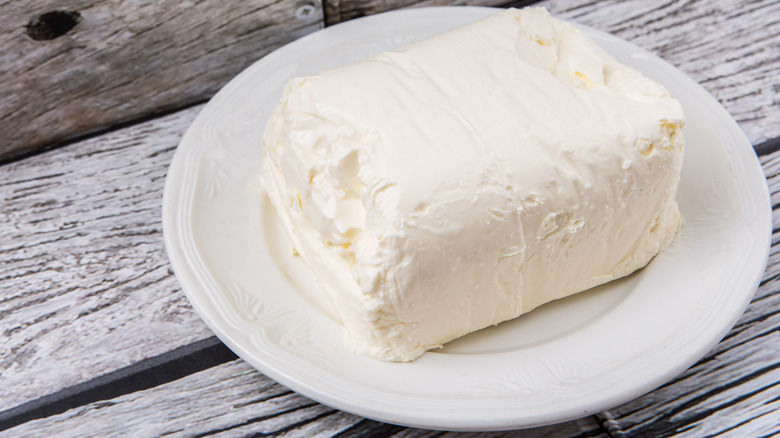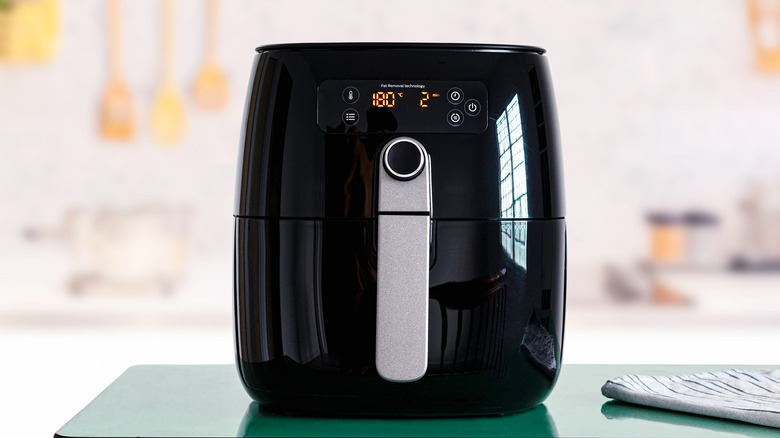How To Adequately Soften Cream Cheese
If you're baking up a recipe that calls for cream cheese, chances are you'll want it softened before you mix it in. It may still be a little solid when fresh out of the fridge and can be difficult to incorporate. It may blend with extra effort, but the finished product could look lumpy. Softening the it, however, can help it blend out smoother.
You can soften cream cheese by leaving it on the counter, though you'll want to time it correctly. According to the U.S. Food and Drug Administration, cream cheese can be safely left out for around two hours (if the temperature is above 90 degrees Fahrenheit, this halves to an hour). After that, food-borne illness-causing bacteria can grow. That risk is greater when temperatures are higher.
A tub of your favorite cream cheese brand can be left unopened, while a block should be removed from cardboard packaging but left in the foil wrapper. Generally, cream cheese will soften within 30 minutes to an hour when left on the counter, so you shouldn't risk pushing it into the danger zone. If you're short on time, you can cut up the cream cheese on a plate then cover it with plastic wrap. The air will be able to cover more surface area.
You can soften cream cheese by hand
If you forget to set out your cream cheese before you need it, there are faster methods to soften it. In general, blocks of cream cheese work better for softening than tubs. To quickly smooth out your spread, all you need is a little heat.
If you want the cream cheese from a block softened faster, fill a bowl with warm water (not too hot — cream cheese can curdle at higher temperatures). Make sure the wrapper is still sealed to prevent water from getting in, and add the entire block into the water. Turn it every few minutes to ensure the whole cream cheese is warmed. After 10 to 15 minutes, the block should be soft enough to add to your recipe.
If you have a block still wrapped in the packaging, you can massage it in your hands to soften the cream cheese. The warmth from your hands combined with the motion of moving it around will soften the block in about 10 minutes. While it may take a little extra elbow grease to get the cream cheese to the right consistency, you'll be able to feel just how soft it is and know exactly when to stop.
Appliances can aid the softening process
If you want your appliances to do the work for you, you can also microwave cream cheese to soften it — just make sure you remove it from the metallic wrapping if you're using a block, or scoop a tub's contents into a microwave-safe bowl. Heat it in short intervals of around 10 seconds, checking the texture after each heating session. It should be done in about a minute or less. While this method may be quick to soften the cheese, you also run the risk of melting it. Keep an eye on your cream cheese, and stop heating it once it's soft and smooth.
Though it may be a little more unusual, you can use an air fryer. To prevent your cream cheese from melting, you'll want to turn the air fryer to the lowest temperature it can go. Then, cut up the block of cream cheese and place it in the appliance on a sheet of aluminum foil. Allow the cheese to soften in the low heat of the air fryer, and check on it every 30 seconds. It should be sufficiently soft after about a minute or a minute and a half.
Once your cream cheese has been sufficiently softened, it can be smoothly mixed into cheesecake batter, baked in a pound cake, whipped into frosting, or turned into a dessert dip.


